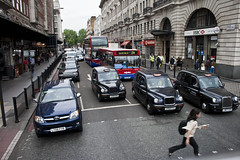The pressing global imperative of driving down CO2 emissions is now accepted by the motor industry.
But while enormous energy was devoted to that campaign by environmentalists, a more immediate threat has been insidiously creeping back along the pavements of busy town and city streets.
The pollutants issuing from the tail pipes of petrol and diesel driven vehicles — buses, lorries and vans as well as taxis and private cars – were some of the original bad environmental news in the 1980s, even before the threat posed by rising CO2 was properly grasped.
Then it all seemed to get better. We were assured that cleaner engines, particularly in diesel vehicles, would drive down emission levels at a steady rate.
We now know that isn’t happening. In fact, far from drifting gently downwards, the line on the graph has kicked worryingly upwards in the UK, now one of the worst countries for air pollution in Europe.
The cause of this unexpected decline in our air quality is quite simple — much more traffic on our urban roads.
The direct, and deadly, effects of rising pollution were outlined in a report this summer (2010) by the Environmental Audit Committee. it estimatedthat 8000 people a year were dying prematurely in London of respiratory conditions linked to air quality. In the whole of Britain the figure was nearer 50,000.
A campaign to to help combat the UK’s rising problem of poor air quality, and to bring action to improve the situation, has been launched in an unlikely quarter — the car industry.
Volvo Car UK has launched a plan aimed at providing all motorists with a broader range of emissions information when they buy their next car – irrespective of marque.
The company said it was time to educate drivers on a car’s complete emissions picture, rather than just CO2 in isolation. “Automotive emissions other than CO2 (NOx, Hydrocarbons and Particulates) are the key contributors to poor air quality, particularly in urban areas, and are one of the main reasons why the UK suffers from one of the highest recordable asthma rates in the world,” said a Volvo spokesman.
Volvo’s is launching a car air pollutants environmental label to sit alongside the already established CO2 label displayed in new and used car showrooms. To support this it will be issuing a phone app to give drivers total emissions information when they visit a new or used car showroom.
The company has set up a the Emissions Equality Think Tank to help keep the issue of air quality in the public’s mind, and under the media’s gaze.
The big problem for the customer is this. When we buy a low-CO2 emitting model, petrol or diesel, it doesn’t mean we are necessarily selecting a car whose other emissions are low too. And it’s the non-CO2 emissions that are affecting immediate air quality and health.
You can find this out through the government’s own Vehicle Certification Agency (VCA) data (www.vca.gov.uk). It’s also on www.CleanGreenCars.co.uk.
It doesn’t necessarily follow that a small cars is less polluting. The comparison between larger Volvo estate and saloon models against small cars is instructive. A Volvo V70 premium estate 2.5 petrol manual generates 201mg/km of non-CO2 pollutants, compared with the 1.4 litre Fiat 500 Start Stop which, at 484mg/km, generates more than twice as many other pollutants.
(Volvo, not surprisingly, cite their own models, and the figures are very positive. The company accepts that there is commercial benefit to them from such a campaign, but points out that the information it wants to put into the car showroom will help buyers choose other makers’ low emission vehicles as well.)
Volvo point out that they were among the first manufacturers to produce “cleaner” cars, and the first company to sign up to the 1992 Kyoto Treaty on Climate Change.
Peter Rask, Volvo Car UK’s Managing Director, said: “This is is more about encouraging greater transparency in the automotive industry across all emissions. It isn’t about reducing the focus on CO2; our campaign is about all drivers being given easy access to the complete set of pollutants information so they can make a more informed decision when they buy a new or used car.”
Footnote.
Volvo believes there is room for a new environmental label similar to the one in the United States of America, run by the US Environmental Protection Agency which scores the environmental impact of vehicles, including both air quality and CO2 emissions. http://www.epa.gov/greenvehicles/Index.do.
The Vehicle Certification Agency’s description of non CO2 emissions is :
CO – Carbon monoxide reduces the oxygen carrying capacity of the blood.
HC – Hydrocarbons contribute to ozone formation. Some kinds of HCs can also be carcinogens and are also indirect greenhouse gases.
NOx – Oxides of nitrogen react in the atmosphere to form nitrogen dioxide (NO2) which can have adverse effects on health, particularly among people with respiratory illness.
For further discussion and debate, see www.facebook.com/insidevolvouk and

